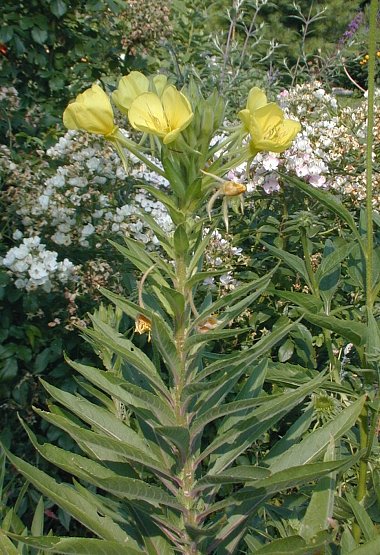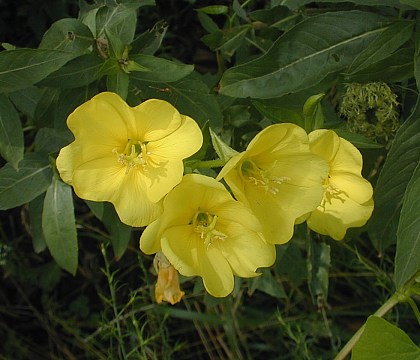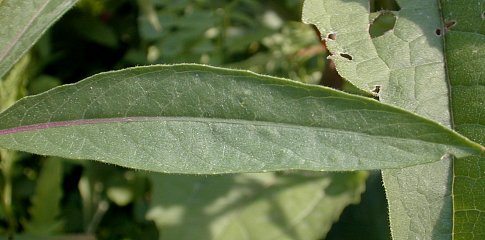Description: This biennial plant can be 7' tall, although it is often shorter. There is usually a central stem with alternate leaves, but sometimes there will be multiple stems in open areas, creating a bushy appearance. The stems are light green or red, and are covered with white hairs. The light or olive green leaves are up to 8" long and 2" wide, but usually smaller. They are lanceolate and resemble willow leaves. The margins of the leaves are smooth or slightly dentate, and are nearly hairless. Smaller secondary leaves often appear at the axils of major leaves on the central stem. A panicle of pale yellow flowers occurs at the apex of the plant (or at the ends of major stems, if the plant is bushy). Each flower is about 1" across when fully open, with 4 petals and prominent stamens, and a long green calyx. The flowers remain open from evening to early morning, but will remain open longer on cloudy days. They have a mild lemony scent, and bloom from mid-summer to fall on mature plants. Long narrow seedpods develop, which split open from the top to release many tiny, irregular brown seeds. They are small enough to be dispersed by the wind, and can remain viable in the soil after 70 years. The root system consists of a fleshy taproot.

Cultivation:
The
preference is full sun, average moisture, and a soil that is somewhat
sandy, but other growing conditions are acceptable. This plant forms a
stubby rosette during the first year, but becomes tall during the
second year, at which time it flowers, sets seed, and dies. Common
Evening Primrose is easy to grow, but often becomes rather unsightly as
the season progresses. Disease can cause small brown spots to form on
the leaves, while drought causes the lower leaves to turn yellow and
fall off the plant.
Range & Habitat:
Common Evening Primrose occurs in every county of Illinois (see Distribution
Map), where it is native. This common plant is particularly
conspicuous
during late summer or fall. Disturbed areas are favored in both natural
and developed habitats, including mesic to dry black soil prairies,
sand prairies, thickets, glades, lakeshore dunes, abandoned fields,
roadsides and railroads, slopes of drainage ditches, vacant lots, etc.
Sometimes this plant is cultivated in wildflower gardens, from which it
may escape.

Faunal Associations: Moths pollinate the flowers, particularly Sphinx moths. Other occasional visitors include the Ruby-Throated Hummingbird, honeybees, bumblebees, and Anthedonia compta (Primrose Miner Bee), the latter being an oligolege. These insects seek nectar, although some of the bees collect pollen. The caterpillars of several moths feed on the foliage. This includes Endryas unio (Pearly Wood Nymph), Desmia funeralis (Grape Leaffolder Moth), Hyles lineata (White-Lined Sphinx), and Mompha eloisella (Momphid Moth; bores through stems). Various beetles feed on the foliage, including Popillia japonica (Japanese Beetle), Grahops pubescens (Leaf Beetle sp.), Altica fusconenea (Flea Beetle sp.), and several Curculio beetles. The seeds are eaten by goldfinches.

Photographic
Location:
The photographs were taken at a flower garden in Urbana, Illinois, and
at Meadowbrook Park in the same city.
Comments:
During the first year of growth, the roots can be cooked and eaten.
This is by far the most common evening primrose (Oenothera) in
Illinois. Although it favors disturbed weedy areas, this species is
sometimes found in prairies and other natural areas. Common Evening
Primrose can be distinguished from other Oenothera spp. on
the basis of its tallness (often exceeding 3' in length), the shape of
its seed capsules (rounded edges, rather than sharply angular), the
shape of its leaves, and the size of its flowers. There is
significant variation in the hairiness of individual plants. For more
information about these distinctions, see Mohlenbrock (2002).